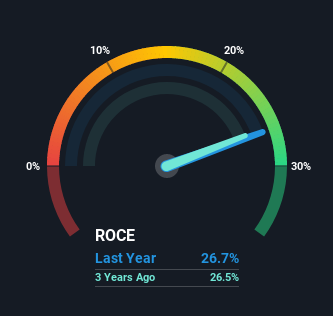
If we want to find a stock that could multiply over the long term, what are the underlying trends we should look for? One common approach is to try and find a company with returns on capital employed (ROCE) that are increasing, in conjunction with a growing amount of capital employed. Put simply, these types of businesses are compounding machines, meaning they are continually reinvesting their earnings at ever-higher rates of return. And in light of that, the trends we're seeing at Computacenter's (LON:CCC) look very promising so lets take a look.
Return On Capital Employed (ROCE): What is it?
Just to clarify if you're unsure, ROCE is a metric for evaluating how much pre-tax income (in percentage terms) a company earns on the capital invested in its business. The formula for this calculation on Computacenter is:
Return on Capital Employed = Earnings Before Interest and Tax (EBIT) ÷ (Total Assets - Current Liabilities)
0.27 = UK£237m ÷ (UK£2.3b - UK£1.4b) (Based on the trailing twelve months to June 2021).
Therefore, Computacenter has an ROCE of 27%. That's a fantastic return and not only that, it outpaces the average of 14% earned by companies in a similar industry.
Check out our latest analysis for Computacenter

Above you can see how the current ROCE for Computacenter compares to its prior returns on capital, but there's only so much you can tell from the past. If you'd like, you can check out the forecasts from the analysts covering Computacenter here for free.
What The Trend Of ROCE Can Tell Us
The trends we've noticed at Computacenter are quite reassuring. The numbers show that in the last five years, the returns generated on capital employed have grown considerably to 27%. Basically the business is earning more per dollar of capital invested and in addition to that, 130% more capital is being employed now too. So we're very much inspired by what we're seeing at Computacenter thanks to its ability to profitably reinvest capital.
On a separate but related note, it's important to know that Computacenter has a current liabilities to total assets ratio of 62%, which we'd consider pretty high. This can bring about some risks because the company is basically operating with a rather large reliance on its suppliers or other sorts of short-term creditors. While it's not necessarily a bad thing, it can be beneficial if this ratio is lower.
Our Take On Computacenter's ROCE
A company that is growing its returns on capital and can consistently reinvest in itself is a highly sought after trait, and that's what Computacenter has. Since the stock has returned a staggering 294% to shareholders over the last five years, it looks like investors are recognizing these changes. Therefore, we think it would be worth your time to check if these trends are going to continue.
One final note, you should learn about the 2 warning signs we've spotted with Computacenter (including 1 which can't be ignored) .
High returns are a key ingredient to strong performance, so check out our free list ofstocks earning high returns on equity with solid balance sheets.
New: AI Stock Screener & Alerts
Our new AI Stock Screener scans the market every day to uncover opportunities.
• Dividend Powerhouses (3%+ Yield)
• Undervalued Small Caps with Insider Buying
• High growth Tech and AI Companies
Or build your own from over 50 metrics.
Have feedback on this article? Concerned about the content? Get in touch with us directly. Alternatively, email editorial-team (at) simplywallst.com.
This article by Simply Wall St is general in nature. We provide commentary based on historical data and analyst forecasts only using an unbiased methodology and our articles are not intended to be financial advice. It does not constitute a recommendation to buy or sell any stock, and does not take account of your objectives, or your financial situation. We aim to bring you long-term focused analysis driven by fundamental data. Note that our analysis may not factor in the latest price-sensitive company announcements or qualitative material. Simply Wall St has no position in any stocks mentioned.
About LSE:CCC
Computacenter
Provides technology and services to corporate and public sector organizations in the United Kingdom, Germany, France, North America, and internationally.
Very undervalued with flawless balance sheet and pays a dividend.


